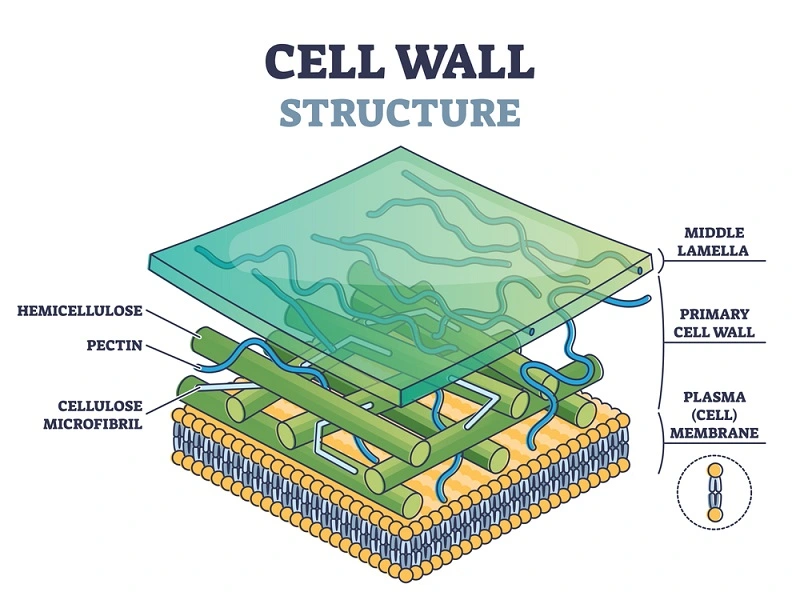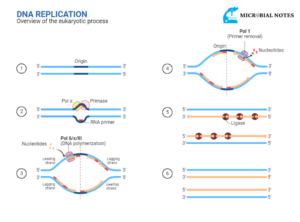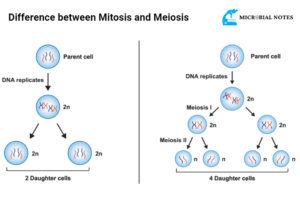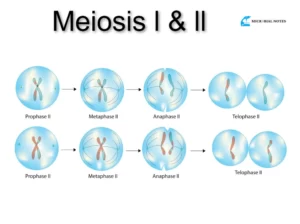History:
Know the brief history of cell wall:
In 1665, Robert Hook was the first scientist who observed and named the cell.
In 1804, Karl Rudolph and J.H.F. see the cell had many cell walls which are independent.
Also read: Introduction to cell biology
What is a cell wall?
The cell wall is the outermost layer of the cell next to the plasma or cell membrane. It is mostly present in plant cells, fungi, algae, bacteria, and archaea. In animals, the cell wall is absent.
Diameter or size:
The diameter or size of the plant cell wall is 0.1 to several micrometers but it is different in primary and secondary cell walls.
Structure of cell wall:
Its structure is rigid, semi-permeable is made up of cellulose or chitin. It is also flexible or tough.

Parts of eukaryotic cell wall:
The cell wall has three layers:
- Primary Cell wall
- Middle layer lamella
- Secondary cell wall
- Tertiary cell wall but rare.
Primary cell wall:
When the eukaryotic cell is growing it forms a thin, flexible, and extensible layer called the primary cell wall. It is produced in young growing cells. The primary cell wall is present in all cells. It lacks pits. It is cellulose containing but cellulose content is low in the primary cell wall it has a high content of hemicellulose, protein, and lipid contents. When the cell is dividing, it laid down the cells.
The primary cell wall is arranged in the inner middle layer of the lamella. It is totally layered and competent in extension. The arrangement of cellulose fibrils is shorter, wavy, and slack. The primary cell wall is slim. It is 1-3 micrometers thick.
Middle layer lamella:
It is a layer that sticks together the primary cell walls of the neighboring plant cells. It is made up of magnesium and calcium. At the time of cytokines, it is the first layer of coating or covering.
In mature plant cells, the middle lamella is the outermost covering of the cell wall and it is difficult to differentiate from the primary cell wall. The adjacent cells will separate when the degradation of enzyme occurs in the middle lamella e.g. during fruit ripening.
Secondary cell wall:
The secondary cell wall is present in plant cells. It is present between the primary cell wall and the plasma membrane. The secondary cell wall is present in specific cells and involved in mechanical support and water transportation. It has pits at certain places. and quite thick-walled.
It provides protection, rigidity, and strength to plants. The cell stops expanding when the primary cell wall is complete. After completing the primary cell wall the secondary cell starts producing. The secondary cell wall consists of cellulose, polysaccharide, lignin, and glycoprotein.
It has relatively high cellulose content but low content of hemicellulose, protein, and lipid contents. It is arranged inside the primary cell wall. Cellulose microfibrils are also present in the secondary cell wall and are longer, parallel, straight, and arranged. Lipid is absent or almost negligible in the secondary cell wall. It is 5-10 micrometers thick.
Tertiary cell wall:
In gymnosperm woods the innermost layer contains xylan and it is called the tertiary cell wall. The tertiary cell wall is made up of cellulose and lignin. It develops on the inner surface of the secondary cell wall. The tertiary cell wall is quite rare in the plant cell wall.
The function of the eukaryotic cell wall:
The eukaryotic Cell wall performs different functions:
- When water enters the cell, it acts as s pressure vessel, which prevents the over-expansion of the cell.
- Provides structure for the cell, protection, and, support also.
- Provides protection when a pathogen encounters.
- Allows the transportation of substances from the inside of the cell to the outside.
- The composition of chemical and mechanical properties is linked with the growth of cell walls and the morphogenesis process.
Morphogenesis:
It is a biological process that causes a tissue or organ to develop its shape by controlling the division or sharing of cells during embryonic development e.g. Cancer.
Composition of cell wall:
The cell wall consists of cellulose, non-cellulosic, hemicellulose, pectic polysaccharides, phenolic compounds, proteins, lignin, pectin, suberin, cutin, chitin, pseudo peptidoglycan, and water. They are all essential and play their role in the cell wall.
Cellulose:
The cellulose provides the mechanical strength of the eukaryotic cell wall. Cellulose content is low in the primary cell wall but its content is high in the secondary cell wall.
Non cellulose:
Cellulose is not present in it e.g. in bacteria cellulose is absent because its cell wall is from peptidoglycan.
Hemicellulose:
Hemicellulose strengthens the cell wall in relation to cellulose but in some cells, in relation to lignin. it is 50% present in the primary cell wall. 25% hemicellulose in the secondary cell wall.
Pectic polysaccharides:
It includes glacturonans and rhamnogalacturonan-I.
Phenolic Compounds:
Phenolic compounds are esters linked to the cell wall, but phenol disrupts the cell wall of microorganisms resulting from cell lysis or bursting.
Proteins:
They are responsible for almost every task of cellular life e.g. cell shape, cell maintenance, cleaning up waste, manufacturing of products, etc. In the primary cell wall, the protein content is high up to 5%. The protein content is relatively low in the secondary cell wall 1% or less.
Lignin:
It is an organic polymer and is huge in the cell wall of some specific cells. Lignin is absent in the primary cell wall but lipid content is present in almost 5-10%. Lignin is absent in the secondary cell wall.
Pectin:
It is an important component of cell walls which helps in cell adhesion and wall hydration. In fruit plants, pectin helps in the ripening of fruits and retaining the shape of the fruit.
Suberin:
It is a lipophilic (ability to combine with or dissolve in fats, lipids, oils, and polar solvents e.g. hexane) macromolecule present in the cell wall. It plays an important role in the insulation or protection of the surrounding cell wall. Suberin is absent in the secondary cell wall.
Cutin:
It is a complex polymer and acts as an impermeable and waterproof barrier and its role is the same as suberin.
Pseudopeptidoglycan:
Pseudopeptioglycan is present in the archaeal cell. It plays a role in the shape and structure of the cell and provides protection which is harmful to the cell.
Water:
Hydration is 60% in the primary cell wall. Hydration in the secondary cell wall is 30-40% less than in the primary cell wall. If a healthy supply of water turgor pressure remains a plant from drooping or wilting
Reference







